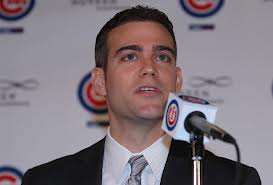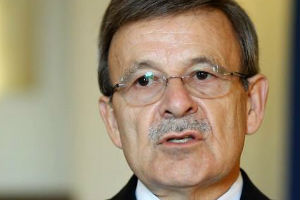 This last weekend I attended the Chicago Cubs Convention with my family. As we drifted from session to session, I couldn’t help but see all sorts of blog themes and things that non-profit organizations could learn from this major league franchise. I will use the next few days to share a few of these observations and hopefully stimulate a few new ideas for you and your agency. Today, I want to drill down on the idea of stewardship.
This last weekend I attended the Chicago Cubs Convention with my family. As we drifted from session to session, I couldn’t help but see all sorts of blog themes and things that non-profit organizations could learn from this major league franchise. I will use the next few days to share a few of these observations and hopefully stimulate a few new ideas for you and your agency. Today, I want to drill down on the idea of stewardship.
In one of the sessions that I attended, there sat Cubs General Manager Theo Epstein and the brain trust for the entire Chicago Cubs organization. There was a lot of talk about improving the stadium, improving the product of the field, and a lot of blah-blah-blah. I’ve attended a number of these conventions, and I always marvel at how I am paying them to market to me. I also can’t believe that the script never seems to change very much.
However, something struck me as very interesting this year. It was Theo’s second convention since being hired, and I heard him say this:
“The Cubs have a covenant with the fans.”
This isn’t the first time that I’ve heard him say this. I heard it at last year’s convention. I’ve heard it and read it in various media interviews. And this time it sparked the following questions and thoughts:
- I wonder what he means by that?
- He is emphasizing this point . . . this must be part of a larger narrative?!?!
- This sounds and feels remarkably similar to non-profit stewardship efforts. Huh?
 So, I went back to the basics and looked up the word “covenant” and thefreedictionary.com defines it as follows:
So, I went back to the basics and looked up the word “covenant” and thefreedictionary.com defines it as follows:
“cov·e·nant (kuv’e-nent) noun. 1. A binding agreement; a compact.”
Of course, every time I hear this word it takes me back to my childhood and confirmation classes. There are obvious Biblical connotations.
I believe that when Theo talks about this covenant with Cubs fans, he is referring to:
- Transparency,
- Accountability,
- Reporting,
- Recognition, and
- essentially demonstrating that the team is doing what they say they’re doing.
Isn’t this exactly what non-profit organizations mean when they talk about stewardship? I believe so.
If you agree, then this raises another interesting question: “With whom does your agency have a covenant?”
I believe that non-profit professionals and board volunteers form a covenant with many different stakeholders such as: donors, clients, collaborative partners, staff, funding partners and institutions (e.g. United Way and other foundations), and the at-large community. While there are common threads that run through each of those covenants, there are also some unique promises being made by your organization.
Have you ever thought through this part of your social contract? If not, then I suggest this might be an interesting “generative discussion” at an upcoming board meeting.
After a little more thinking, I started identifying ways the Chicago Cubs try to hold up their end of this covenant. For example:
- The annual convention is in part an accountability exercise where ownership, management and players open themselves up to answering questions (e.g. ticket pricing, player acquisition, organizational development philosophy, etc).
- The Cubs talked a lot about investing time and resources last year in fan surveys and focus groups.
- The Cubs publish a magazine called “Vine Line” in an effort to keep fans informed.
How is this any different that what some non-profit organizations do with newsletters, annual meetings, and donor communications.
As I always say . . . “We can all learn from each other.” And I do mean ALL because the Chicago Cubs Convention proves to me that there is more commonality between for-profits and non-profits than we care to admit.
What is your non-profit agency doing to fulfill its covenant? With whom do you think you have a covenant? What tactics are you using? Where do you find your inspiration and new ideas? Who do you see doing a good job with this?
Here’s to your health!
Erik Anderson
Founder & President, The Healthy Non-Profit LLC
www.thehealthynonprofit.com
erik@thehealthynonprofit.com
http://twitter.com/#!/eanderson847
http://www.facebook.com/eanderson847
http://www.linkedin.com/in/erikanderson847








 I hope your New Years celebration was fun, safe and full of family and friends. Welcome to 2013 and an exciting new opportunity for you and your non-profit organization.
I hope your New Years celebration was fun, safe and full of family and friends. Welcome to 2013 and an exciting new opportunity for you and your non-profit organization. Welcome to O.D. Fridays at DonorDreams blog. Every Friday for the foreseeable future we will be looking more closely at a recent post from John Greco’s blog called “
Welcome to O.D. Fridays at DonorDreams blog. Every Friday for the foreseeable future we will be looking more closely at a recent post from John Greco’s blog called “ This phenomenon is called the “crowding out effect” and I wrote about it in the following blog posts in 2011:
This phenomenon is called the “crowding out effect” and I wrote about it in the following blog posts in 2011: The crowding out effect is real, and it is something non-profit organizations need to understand and deal with. If not, then I advise putting the following age-old expression in a frame above the boardroom door: “The road to hell is paved with good intentions.”
The crowding out effect is real, and it is something non-profit organizations need to understand and deal with. If not, then I advise putting the following age-old expression in a frame above the boardroom door: “The road to hell is paved with good intentions.” Fundraising policies
Fundraising policies Welcome to O.D. Fridays at DonorDreams blog. Every Friday for the foreseeable future we will be looking more closely at a recent post from John Greco’s blog called “
Welcome to O.D. Fridays at DonorDreams blog. Every Friday for the foreseeable future we will be looking more closely at a recent post from John Greco’s blog called “ Yesterday morning Jimmie Alford died of an apparent heart attack at the age of 69. This sad news started circulating slowly as the day unfolded, and then it snowballed into an online viral event and my email inbox is full of people sharing the news, their grief, and their disbelief.
Yesterday morning Jimmie Alford died of an apparent heart attack at the age of 69. This sad news started circulating slowly as the day unfolded, and then it snowballed into an online viral event and my email inbox is full of people sharing the news, their grief, and their disbelief.